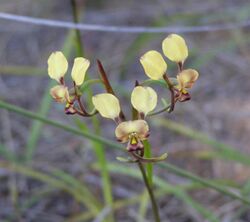Biology:Diuris recurva
| Mini donkey orchid | |
|---|---|

| |
| Scientific classification Error creating thumbnail: Unable to save thumbnail to destination
| |
| Kingdom: | Plantae |
| Clade: | Tracheophytes |
| Clade: | Angiosperms |
| Clade: | Monocots |
| Order: | Asparagales |
| Family: | Orchidaceae |
| Subfamily: | Orchidoideae |
| Tribe: | Diurideae |
| Genus: | Diuris |
| Species: | D. recurva
|
| Binomial name | |
| Diuris recurva | |
Diuris recurva, commonly called the mini donkey orchid[2] is a species of orchid that is endemic to the south-west of Western Australia. It has one or two leaves at its base, up to six small pale yellow and brownish flowers and grows in winter-wet places between Badgingarra and Kalbarri.
Description
Diuris recurva is a tuberous, perennial herb with one or two linear leaves that are 100–150 mm (4–6 in) long, about 5 mm (0.2 in) wide and folded lengthwise. Up to six pale yellow flowers with brownish to dark burgundy-coloured markings, 16–20 mm (0.6–0.8 in) long and 12–16 mm (0.5–0.6 in) wide are borne on a flowering stem 200–300 mm (8–10 in) tall. The dorsal sepal curves upwards, often backwards and is egg-shaped with the narrower end towards the base, about 8 mm (0.3 in) long and 7 mm (0.3 in) wide. The lateral sepals are linear to lance-shaped, green or reddish, 9–12.5 mm (0.4–0.5 in) long, about 2 mm (0.08 in) wide, turned downwards and usually crossed over each other. The petals are more or less erect with an egg-shaped blade 10–13 mm (0.4–0.5 in) long and 4–6.5 mm (0.16–0.26 in) wide on a greenish-brown stalk 4–6 mm (0.16–0.24 in) long. The labellum is 4–5 mm (0.16–0.20 in) long and has three lobes. The centre lobe is spatula-shaped, 3–4.5 mm (0.1–0.2 in) wide and dark reddish brown with yellow patches. The side lobes are 4–5 mm (0.16–0.20 in) long and 3 mm (0.1 in) wide and curve backwards. There is a single raised, ridge-like callus along the mid-line of the labellum. Flowering occurs in July and August.[2][3][4][5]
Taxonomy and naming
Diuris recurva was first formally described in 1991 by David Jones from a specimen collected near Northampton, and the description was published in Australian Orchid Review.[6] The specific epithet (recurva) is a Latin word meaning "recurved", referring to the petals and lateral sepals that are curved backwards.[3]
Distribution and habitat
The mini donkey orchid grows mostly in winter-wet heath between Badgingarra and Kalbarri in the Avon Wheatbelt, Geraldton Sandplains and Jarrah Forest biogeographic regions.[4][7]
Conservation
Diuris recurva is classified as "Priority Four" by the Government of Western Australia Department of Parks and Wildlife,[7] meaning that is rare or near threatened.[8]
References
- ↑ "Diuris recurva". Australian Plant Census. https://biodiversity.org.au/nsl/services/apc-format/display/117451.
- ↑ 2.0 2.1 Jones, David L. (2006). A complete guide to native orchids of Australia including the island territories. Frenchs Forest, N.S.W.: New Holland. p. 136. ISBN 1877069124.
- ↑ 3.0 3.1 Jones, David L. (1991). "New taxa of Australian Orchidaceae". Australian Orchid Research 2: 61–62.
- ↑ 4.0 4.1 Brown, Andrew; Dixon, Kingsley; French, Christopher; Brockman, Garry (2013). Field guide to the orchids of Western Australia : the definitive guide to the native orchids of Western Australia. Simon Nevill Publications. p. 210. ISBN 9780980348149.
- ↑ Hoffman, Noel; Brown, Andrew (2011). Orchids of South-West Australia. (3rd ed.). Gooseberry Hill: Noel Hoffman. p. 458. ISBN 9780646562322.
- ↑ "Duiris recurva". APNI. https://id.biodiversity.org.au/instance/apni/551666. Retrieved 4 April 2018.
- ↑ 7.0 7.1 "Diuris recurva". FloraBase. Western Australian Government Department of Parks and Wildlife. https://florabase.dpaw.wa.gov.au/browse/profile/12936.
- ↑ "Conservation codes for Western Australian Flora and Fauna". Government of Western Australia Department of Parks and Wildlife. https://www.dpaw.wa.gov.au/images/documents/plants-animals/threatened-species/Listings/Conservation%20code%20definitions.pdf. Retrieved 25 July 2019.
Wikidata ☰ Q10267416 entry
 |


